St. Marcellus I (308-309) 31st Pope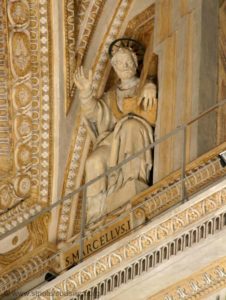
The persecutions were so great that there was no pope for four years
He was very strict against those Christians who had been guilty of weakness and idolatry during the persecutions
For refusing to adore the idols, He was forced into slavery as stable horse groom
He decreed that a council could not be held without authorization by the pope
St. Eusebius (310) 32nd Pope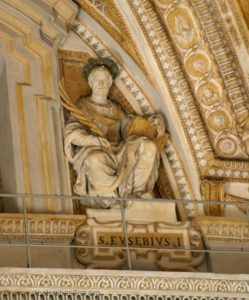
He fought against Rigorists who refused to administer penance against people who lapsed during the persecutions.
He fought against Heraclius and others who demanded that the lapsi be readmitted to the sacraments without penance
St. Miltiades (311-314) 33rd Pope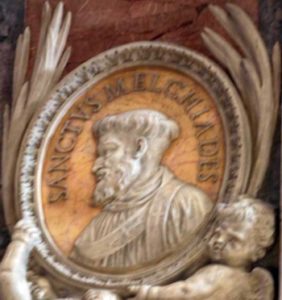
He was able to obtain the confiscated Church assets from the emperor
Constantine became the new emperor
Constantine allowed liberty to the Christians and the freedom of church building
In 313 Constantine enacted the Edict of Milan which allowed toleration of all religions in the empire
Birthrates and marriages dwindled sharply due to the decadent Roman lifestyle. Abortion, homosexuality, widespread divorce, and contraception prevailed.
To combat these evils, Constantine ordered that new marriage laws be based on the Church’s principles
Constantine gave the Lateran Palace to the papacy. This would be the place were the popes would preside. Today, it houses the administrative offices of the Diocese of Rome.
This cathederal is dedicated to John the Evangelist and John the Bapist. It is the first cathedral in Rome
St. Miltiades convened a synod condemning the Donatists as heretics
Blessed bread dates from this time
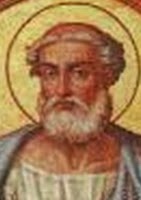
St. Sylvester I (314-335) 34th Pope
The Church continued to benefit from Constantine’s patronage. The basilica of St. Peter, the Holy Sepulchre in Jerusalem, and Nativity in Bethlehem were given to the Church. Building and renovation of St. John Lateran continues.
Sylvester helped Constantine in his continuing education in Christiantity
Some Christians believed that Christ was the highest of God’s creatures (not God) (Arianism)
Sylvester and Constantine jointly convened the First Council at Nicaea, the imperial summer home.
Sylvester send Bishop Hosius of Cordova to preside over the 250 bishops in his name
The council condemened Arianism and composed the Nicene Creed used at Mass today
The Nicene Creed affirms Christ’s status as 2nd Person of the Holy Trinity
Sylvester instituted Sunday as a holy day in memory of the resurrection
Contstantine was most likely baptized at his deathbed
St. Marcus I (336) 35th Pope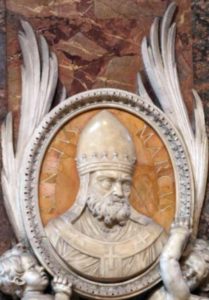
He decreed the use of the pallium to be worn by only popes, denoting their authority.
This a wool garment from a previously blessed lamb, decorated with black crosses
St. Julius I (337-352) 36th Pope
He convened a synod condemning Arianism
He convened a council reaffirming the decrees of Nicaea against the Arians. This This council allowed deposed bishops to appeal to the pope.
He ordered that the Church should celebrate Christmas on December 25
He is considered to be founder of the archives of the Holy See
Liberius (352-366) 37th Pope
He was the first pope not to be canonized in 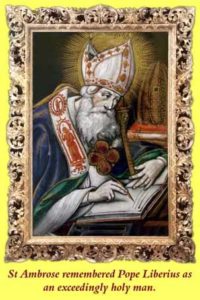 the Western Church.
the Western Church.
He ordered the building of the basilica of St. Mary Major. This site was signified by a Marian apparition and confirmation by a miraculous fall of snow on the lot in the middle of August
The Arian heresy was at its height in influence. The emperor and all but five of the bishops followed Arianism
Bishops, like St. Athanasius, were driven from their dioceses.
Arianism appealed to the intellectuals because it was easily accessible to human reason
Arianism appealed to Jews and the more literate pagans because of its simple monotheism
Arianism de-divinizing of Jesus snipped the tension filled bridge between heaven and earth
Denial of the incarnation put God safely away in heaven, appealing to emperors to reign peacefully on earth
The emperor exiled Liberius and appointed the third anti-pope, Felix II. The emperor convened a “council”, approving several ambiguous semi-Arian creeds.
Under great pressure, Liberius endorsed these semi-Arian creeds in return for being allowed to return to Rome in 358
Similar pressure led Liberius to excommunicate St. Athanasius for a time.
Liberius received opposition for offering pardon for those Arian bishops who would renounce their heresy
Anti Pope Felix II was forced out of Rome. He refused to accept Arianism
St. Damasus I (366-383) 38th Pope
Althought he continued to struggle against Arianism, the tide had turned against this heresy
Some Christians believed that Christ had a human body but no human intellect or free will. His flesh was united with His Godhood. Christ was neither God nor man. (Apollinarianism)
In 368 he convened a synod which condemned Apollinarism
There were three patriarchates in existence: Rome, Alexandria, and Antioch
The defeat and death of the emperor at the hands of the Visogoths (Barbarians) signified the beginning of the end of the Roman empire
The next emperor Theodesius I made Christianity the official religion of the empire. Official Roman citizenship was granted to all who were baptized
Damasus and Theodesius I convened the Council of Constantinople approving the final version of the Nicene Creed as recited today. This council defined and approved the Canon of Scripture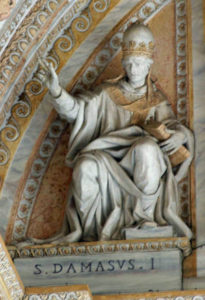
Damasus beautified churches and transformed the catacombs into shrines
He revised the Roman liturgy
He commissioned St. Jerome to make a new translation of the Bible from Hebrew into Latin, becoming the Vulgate
He authorized singing of the psalms by alternate choirs (Abrosian Rite).
He introduced the use of the Hebrew term “alleluia”.
Ursicinus became the fourth anti-pope as a result of opposition to Pope Liberius. Ursicinus, banished by the emperor, eventually converted to Ariansim
St. Siricius (384-399) 39th Pope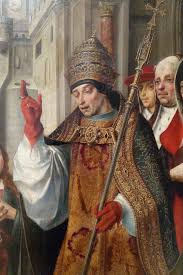
He was strong advocate of the Roman primacy
He issued many decrees for all the churches
His letter to Bishop Himerius of Tarragona is the earliest actual papal decree still existing
He assumed the title of Pope (Papa) from the Greek “Father”
Papa-anagram for Petri Apostoli Potestatem Accipiens
He upheld the necessity of celibacy for priests
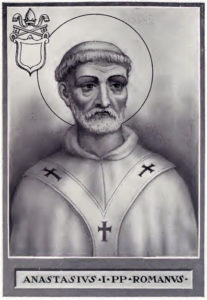
St. Anastasius I (399-401) 40th Pope
He condemned the Origensists (who promote abuses in the Origen’s theology)
He condemned the Donatists
He declared that baptism by Donatists’ clergy to be valid
He declared that repentant Donatist clergy may return to their churches
He maintained that the Divinity was also hidden in material things.
He decreed that priests should remain standing during the gospel
